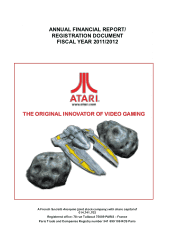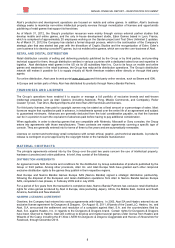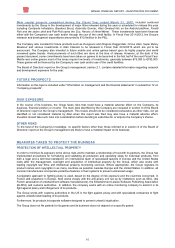Atari 2012 Annual Report Download - page 6
Download and view the complete annual report
Please find page 6 of the 2012 Atari annual report below. You can navigate through the pages in the report by either clicking on the pages listed below, or by using the keyword search tool below to find specific information within the annual report.
ANNUAL FINANCIAL REPORT – REGISTRATION DOCUMENT
6
4. FOCUSING ON PROFITABILITY
To get the most out of available resources and offset a potentially protracted weakness in consumer demand, Atari is
implementing a strict investment and cost control discipline, which includes:
A continued focus to decrease overhead expenses, which has already be achieved through renegotiated vendor
agreements and staff reorganization;
Realignment of Research and Development expenses around mobile and online games, including a
reorganization of its in-house development studios; and
The streamlining of the Group’s offices worldwide.
HISTORY
Atari Inc., founded in 1972, was the pioneer of the video game industry. Infogrames, a French video game company, was
created in 1983 and began trading shares on the Paris stock market in 1993. In 1999, Infogrames acquired a majority
stake in Atari Inc. and the remaining shares were purchased in 2008, making Atari Inc. a wholly-owned subsidiary. The
same year, Infogrames initiated a large restructuring plan after years of acquisition of assets and licenses.
2009 marked the start of a turnaround towards online games, with a continued emphasis on the development of retail
games. In January, the Group issued bonds convertible into new or existing shares with warrants attached (ORANE-
BSA) to finance the acquisition of Cryptic Studios Inc. The Company continued to transition towards a content-led
business model through the sale of Atari Europe’s remaining stake in distribution company Namco Bandai Partners to
long-time partner Namco Bandai Games Europe. This strategic decision was followed, in May of the same year, by the
Company changing its name from Infogrames Entertainment to Atari while writing down a significant impairment of its
remaining legacy activities.
In 2010, the Group completed a successful rights issue, raising €43 million. Jim Wilson, CEO of US subsidiary Atari Inc.,
was appointed to the Board of the Group holding Atari S.A. in October, before being promoted to Group CEO in
December. The Group’s headquarters were transferred from Lyon to Paris.
Since the end of 2010, Atari accelerated its transition to a online gaming company, with mobile games becoming the core
business. Under the lead of Jim Wilson, a new team was appointed to spearhead a more flexible game development
structure in collaboration with third-party studios, as well as an additional focus on brand licensing. In April, the Lyon-
based Eden Studios was restructured. In August, Atari announced the closing of the sale of Cryptic Studios to Perfect
World for €35 million.
The Company is now rolling out the first wave of products derived from its new mobile and online strategy, with several
successful launches including Atari’s Greatest Hits, Breakout Boost, and Asteroids Gunner.
THE MARKET FOR INTERACTIVE ENTERTAINMENT SOFTWARE
The interactive entertainment software industry primarily comprises software for dedicated game consoles or platforms
(such as PlayStation 3, Xbox 360 and Wii), handhelds (such as Nintendo DS and DSi and Sony PSP) and PCs. The
mobile and online gaming segments, dedicated to mobile platforms, including smartphones, tablets and other connected
devices, as well as online via browsers, Facebook and digital downloads, are the fastest growing part of the video game
market.
The traditional videogame market has been widely affected by the difficult economic situation, specifically depleted
consumer spending, ongoing since late 2008. According to International Development Group (IDG), an independent
company specializing in the analysis of statistical data in the fields of technology and media, global (US, Europe and
Japan) software market (including, PC retail, console and handheld) was estimated at approximately USD 22.8 billion in
2011, representing a -5.7% decline when compared to 2010. North American software sales were expecting to decline -
9.7% in 2011 when compared to 2010, and European software sales were expecting to decline -4.6% in 2011 when
compared to 2010.
On the contrary, the digital gaming market (including mobile and online) has been growing strongly over the last few
years. In an analysis dated August 2011, IDG estimates that worldwide non-traditional game market (including, mobile,
tablets, PC game downloads, social gaming, MMOs casual gaming and online console gaming) was expected to
increase to USD 26.3 billion in 2011, representing 24.6% growth compared to 2010.
The Mobile gaming segment was expected to reach USD 5.0 billion, representing a 22.1% increase when compared to
2010. Social gaming was expected to reach USD 2.0 billion, representing a 43.5% increase year-on-year when
compared to 2010; and casual games were expected to increase by 15.0% to USD 2.3 billion when compared to 2010.



















